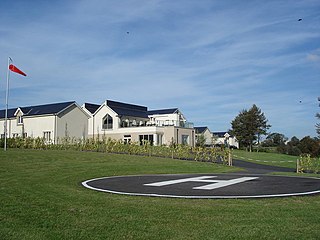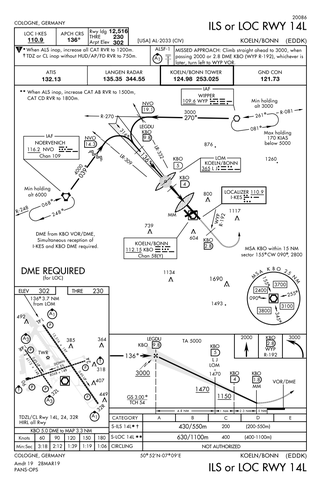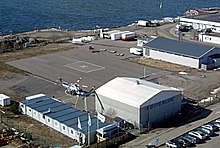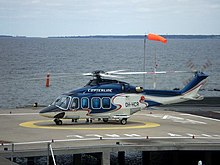
An airport is an aerodrome with extended facilities, mostly for commercial air transport. Airports usually consist of a landing area, which comprises an aerially accessible open space including at least one operationally active surface such as a runway for a plane to take off and to land or a helipad, and often includes adjacent utility buildings such as control towers, hangars and terminals, to maintain and monitor aircraft. Larger airports may have airport aprons, taxiway bridges, air traffic control centres, passenger facilities such as restaurants and lounges, and emergency services. In some countries, the US in particular, airports also typically have one or more fixed-base operators, serving general aviation.

According to the International Civil Aviation Organization (ICAO), a runway is a "defined rectangular area on a land aerodrome prepared for the landing and takeoff of aircraft". Runways may be a human-made surface or a natural surface. Runways, taxiways and ramps, are sometimes referred to as "tarmac", though very few runways are built using tarmac. Takeoff and landing areas defined on the surface of water for seaplanes are generally referred to as waterways. Runway lengths are now commonly given in meters worldwide, except in North America where feet are commonly used.

A helipad is a landing area or platform for helicopters and powered lift aircraft.

An airfield traffic pattern is a standard path followed by aircraft when taking off or landing while maintaining visual contact with the airfield.
Aviation is the design, development, production, operation, and use of aircraft, especially heavier-than-air aircraft. Articles related to aviation include:

An aerodrome or airdrome is a location from which aircraft flight operations take place, regardless of whether they involve air cargo, passengers, or neither, and regardless of whether it is for public or private use. Aerodromes include small general aviation airfields, large commercial airports, and military air bases.

Shearwater Heliport(ICAO: CYAW), formerly known as Canadian Forces Base Shearwater and commonly referred to as CFB Shearwater and formerly named HMCS Shearwater, is a Canadian Forces facility located 4.5 nautical miles east southeast of Shearwater, Nova Scotia, on the eastern shore of Halifax Harbour in the Halifax Regional Municipality. Following a base rationalization program in the mid-1990s, the Canadian Forces closed CFB Shearwater as a separate Canadian Forces base and realigned the property's various facilities into CFB Halifax. These include:
The visual approach slope indicator (VASI) is a system of lights on the side of an airport runway threshold that provides visual descent guidance information during final approach. These lights may be visible from up to 8 kilometres (5.0 mi) during the day and up to 32 kilometres (20 mi) or more at night.

The Downtown Manhattan Heliport is a helicopter landing platform at Pier 6 in the East River in Lower Manhattan, New York, New York.

Olympia Regional Airport is a public use airport located four nautical miles (7 km) south of the central business district of Olympia, a city in Thurston County and the capital of the U.S. state of Washington. It is owned by the Port of Olympia. It is about one mile (1.6 km) east of Interstate 5, actually within the boundaries of the city of Tumwater which is south of and adjacent to Olympia. The airport was identified in the Washington State Department of Transportation Long Term Aviation Study as a field that could potentially serve to relieve Seattle-Tacoma International Airport of increasing congestion.

An aerodrome beacon or rotating beacon or aeronautical beacon is a beacon installed at an airport or aerodrome to indicate its location to aircraft pilots at night.

Approach plates are the printed or digital charts of instrument approach procedures that pilots use to fly instrument approaches during instrument flight rules (IFR) operations. Each country maintains its own instrument approach procedures according to International Civil Aviation Organization (ICAO) standards.
Redcliffe Airport is an aerodrome serving Redcliffe in City of Moreton Bay, Queensland, Australia. It is located 2.5 nautical miles northwest of Redcliffe, in the suburb of Rothwell, accessed via Nathan Road. The facility is owned and operated by Moreton Bay City Council, following the amalgamation of the Redcliffe City Council.
Bunbury Airport is an airport servicing the Western Australian city of Bunbury. Bunbury Airport is located 8 km (5.0 mi) south-east of the city centre and is the only airport serving the city. The airport is used largely as a facility for General Aviation, pilot training and emergency services. Bunbury Airport serves an area that includes the City of Bunbury and the surrounding districts of Harvey, Dardanup, Capel and Donnybrook-Balingup.
Sabre Army Heliport is a military use heliport located at Fort Campbell, seven nautical miles (13 km) northwest of the central business district of Clarksville, in Montgomery County, Tennessee, United States. Owned by the United States Army, it has one runway designated 4/22 with a concrete surface measuring 4,451 by 109 feet.

Bergen Heliport, Grønneviksøren is a heliport situated at Grønneviksøren on the shore of Store Lungegårdsvannet in Bergen, Norway. It is solely used for air ambulance services to Haukeland University Hospital. The heliport is owned and operated by Bergen Hospital Trust. It is the base for a Eurocopter EC-135P2+ operated by Norsk Luftambulanse (NLA) for the Norwegian Air Ambulance. Grønneviksøren is also used by the Royal Norwegian Air Force's 330 Squadron's Westland Sea King search and rescue helicopters.
Stavanger Heliport, University Hospital is a heliport situated on the premises of Stavanger University Hospital in the Våland neighborhood of the city of Stavanger in the municipality of Stavanger in Rogaland county, Norway. Used exclusively for air ambulance services, it is home to a Eurocopter EC-135P2+ operated by Norsk Luftambulanse (NLA) on contract with the National Air Ambulance Service. The base is owned by Stavanger Hospital Trust. When it opened in 1981, it was the second such base in the country.
Dallas CBD Vertiport is a city-owned public heliport/vertiport in the city of Dallas, Dallas County, Texas, United States. The facility is located at the south end of the Kay Bailey Hutchison Convention Center in the Dallas Central Business District, and is claimed to be the world's largest elevated heliport/vertiport.
DeSoto Heliport is a city-owned public heliport in DeSoto, Dallas County, Texas, United States, located 3 nautical miles (5.6 km) north of the central business district. The heliport has no IATA or ICAO designation.













